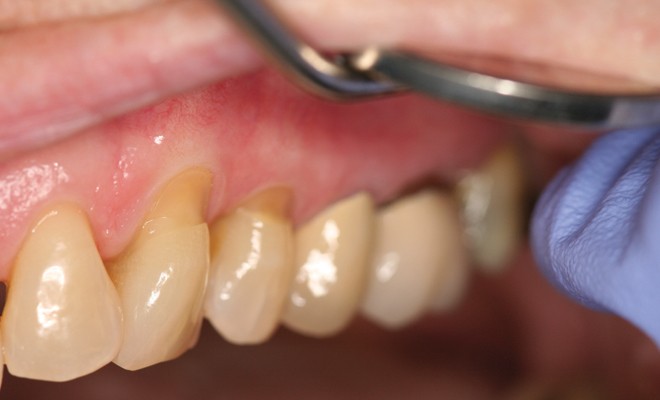Relief For Sensitive, Fragile & Unsightly Teeth
By Anna Giacalone, D.M.D.
The coffee smells wonderful. The ice cream looks great. But you find yourself turning them down because you know how much they’ll make your mouth hurt. And you wonder what’s going on that’s turned the foods and drinks you used to love into the enemy.
The answer is the loss of enamel from the part of a tooth nearest the gum. This loss actually creates “divots” in the tooth, exposing the dentin below and causing painful sensitivity – as well as some other potentially serious problems.
It’s a problem that’s been around forever, but one that’s only recently been fully understood.
In the past, dentists blamed hard toothbrushes and overly aggressive brushing – particularly brushing side to side. Now, though, we understand the problem is usually excessive lateral stress on the neck of the tooth caused by bite problems and/or clenching and grinding. So we’ve declared tooth brushing not guilty and even given the problem a brand new name: “abfraction.”

Why it happens
To understand how abfraction happens, it helps to know that when you bite down you’re actually exerting as much as several hundred pounds of pressure per square inch. That’s not a problem if your teeth are properly aligned. But if your bite is even a tiny bit off, that pressure can cause your teeth to flex.
That is a problem because while the dentin inside your teeth can flex a bit, the hard, brittle enamel on the outside can’t. As a result, as time goes by the enamel begins to separate from the dentin – usually at the neck of a tooth because that’s where the enamel is thinnest.
It’s a slow process and one you’re not likely to notice. But sooner or later this gradual, microscopic damage causes the enamel to sheer off, leaving the characteristic wedge-shaped indentation dentists call an abfraction lesion, or simply an abfraction.
As you can imagine, clenching your teeth or grinding them at night can make the problem even worse.
Common but dangerous
Abfractions, which are quite common in adults, occur most often in the back teeth but they can develop in any part of the mouth. And, when they do they can cause the kind of sensitivity to hot or cold food and drinks you may have noticed. In fact they can even cause painful sensitivity to cold outdoor air.
Other symptoms you may notice include
- Pain when you chew or bite down hard
- Discomfort when you brush or floss
- Actual cracks in the enamel of your teeth
What’s more, abfractions can lead to cavities because they trap food and plaque, and because the exposed dentin is so much softer than enamel. Even worse, they can weaken the structure of your tooth and actually cause it to break.
Solving the problem
Abfraction never get better on its own but there are some simple, highly effective steps we can take to end the danger and the pain.
The first step is to assess your bite and, if it isn’t perfect, take steps to correct it. Basically that involves making sure the force of chewing is distributed over all your teeth so none receives too much pressure. Without this step, the problems that caused your abfraction will continue and may cause more.
Next, I’ll restore the enamel that’s missing using a natural-looking composite material. Doing this will strengthen your tooth and end your sensitivity to hot and cold.
Finally, I’ll most likely make you a custom night guard to protect your teeth from grinding while you sleep.
It’s as simple as that. If tooth sensitivity is keeping you from enjoying the food you love – or if you’ve noticed cracked or missing enamel, just give us a call at 610-558-1760.
We look forward to talking with you.
New Patients: Mention this offer when you call for your first visit
To receive a FREE Exam, PLUS $100 toward your dental treatment.
Available to the first 27 new patients who mention this ad
Not to be combined with other offers
Call to schedule with Dr. Giacalone at 610-558-1760
Anna C. Giacalone, DMD, MAGD
Master of the Academy of General Dentistry
BS. Biology Chestnut Hill College
DMD. University of Pennsylvania School of Dental Medicine
Certificate and Internship: Comprehensive Orthodontic Institute
Certificate: prestigious Dawson Academy of Advanced Study
To learn more visit her web site: www.giacalonedmd.com
Numerous Awards and Commendations including Mastership in the Academy of General Dentistry, The Pennsylvania Dental Association Award for Excellence, Top Cosmetic Dentist Main Line Today, America’s Top Dentists, to name a few.





